- Have any questions? Contact us!
- info@dr-rath-foundation.org

Micronutrients reduce respiratory illnesses in patients with cystic fibrosis
June 7, 2018
More U.S. states file opioid lawsuits against drug firms
June 7, 2018How To Prevent Cardiovascular Disease Naturally, Without Drugs

Cardiovascular disease is the world’s number one killer. Estimated by the World Health Organization to be costing the lives of 17.7 million people every year, four out of five of these deaths are due to atherosclerotic deposits in the arteries leading to heart attacks and strokes. While conventional medicine has failed to prevent the epidemic increase in the incidence of this health problem, Dr. Rath’s Cellular Medicine approach provides a revolutionary breakthrough in our understanding of its underlying cause. Through correctly addressing the root of the problem, the prevention of atherosclerotic cardiovascular disease, and the consequent saving of millions of lives, is now possible.
What is atherosclerosis?
Atherosclerosis is a disease in which fatty molecules and other substances build up in the artery walls. Collectively known as plaque, if the buildup of this material becomes severe the arteries can become narrowed to such an extent that the flow of blood through them is dangerously impeded. Clogging of the coronary arteries raises the risk of heart attacks, while clogging of the arteries supplying blood to the brain raises the risk of strokes.
Conventional medicine sees elevated blood levels of cholesterol as the principal risk factor for the development of atherosclerosis. As a result, over the past three decades, the pharmaceutical industry has been able to build up a multibillion dollar worldwide business selling statin drugs to artificially lower cholesterol levels. But as we shall see next, high cholesterol is not the cause of cardiovascular disease, it is simply the consequence of it.
The REAL cause of atherosclerosis

Lipoprotein(a)
Carried out over a period of more than 25 years, Dr. Rath’s scientific research work has proven that atherosclerotic cardiovascular disease is essentially an early form of the vitamin C deficiency disease scurvy. Unlike animals, humans develop heart disease because their bodies cannot produce vitamin C and they generally obtain insufficient amounts of it in their daily diets. Among its many functions in the body, vitamin C plays an important role in the synthesis of collagen – the key stability molecule for the artery walls and for connective tissue in general.
While the human diet usually provides enough vitamin C to prevent scurvy, this is not enough to guarantee stable artery walls. As a consequence of the constant daily pumping action of the heart and an insufficient supply of vitamin C, millions of tiny cracks and lesions develop in the artery walls. Subsequently, cholesterol and other risk factors enter to repair this damage.
Of all these risk factors, by far the most important is a molecule known as Lipoprotein(a). Primarily found in humans and sub-human primates, Lipoprotein(a) functions as a fat transporting repair molecule that compensates for the structural impairment of the artery wall. In the case of a chronic deficiency of vitamin C, the arterial damage and repair process becomes continuous. The overshooting of the repair process eventually leads to severe atherosclerosis and the occurrence of heart attacks and strokes.
Thus, the real culprit behind atherosclerosis is not cholesterol, but a lack of vitamin C. It therefore follows that the key to preventing heart attacks and strokes is an optimum supply of vitamin C and other collagen-supporting micronutrients. Ensuring a proper intake of these micronutrients helps keep the artery walls in a state of optimal repair.
Dr. Rath’s recommendations for preventing atherosclerosis
In addition to his Basic Cellular Health Recommendations, Dr. Rath recommends that patients with existing atherosclerotic disease, or those at risk of the condition, take the following micronutrients in higher dosages:
| Vitamin C – Provides protection and supports the natural healing of the artery wall; helps reverse plaque. |
| Vitamin E – Provides antioxidant protection. |
| Vitamin B6 – Protects against increased levels of homocysteine (a risk factor for coronary artery disease) together with folic acid and betaine. |
| Vitamin D3 – Optimizes calcium metabolism and the reversal of calcium deposits in the artery wall. |
| Folic Acid – Protects against increased levels of homocysteine (a risk factor for coronary artery disease) together with vitamin B6 and betaine. |
| L-Proline – Supports collagen production, stability of the artery wall, and the reversal of plaque. |
| L-Lysine – Supports collagen production, stability of the artery wall, and the reversal of plaque. |
| Copper – Supports stability of the artery wall via the improved cross-linking of collagen molecules. |
| Betaine – Protects against increased levels of homocysteine (a risk factor for coronary artery disease) together with vitamin B6 and folic acid. |
| Chondroitin Sulfate – Supports the stability of the artery wall by acting as a ‘cement’ for connective tissue. |
| N-Acetylglucosamine – Supports the stability of the artery wall by acting as a ‘cement’ for connective tissue. |
To learn more about the use of Dr. Rath’s Cellular Medicine approach for preventing atherosclerosis, heart attacks and strokes, read chapter 2 of his book, Why Animals Don’t Get Heart Attacks…But People Do!
As always, if you have any questions, please feel free to contact us.



